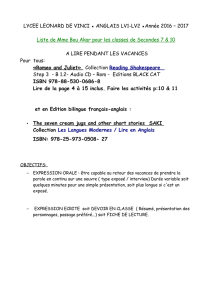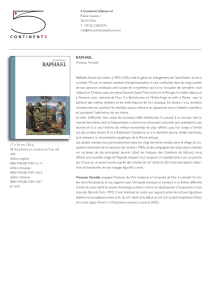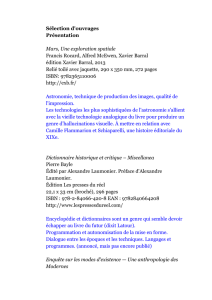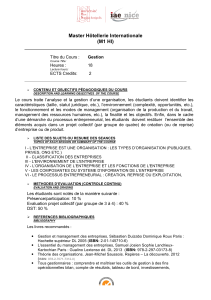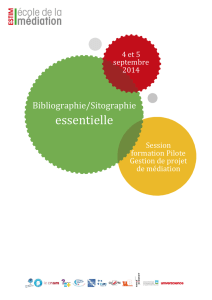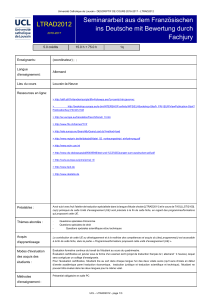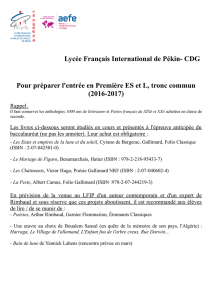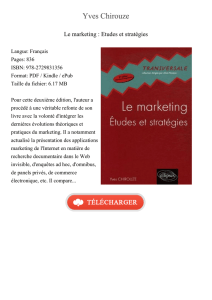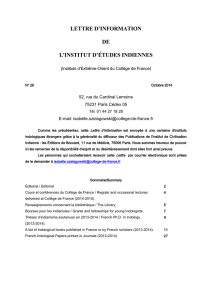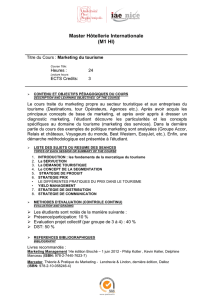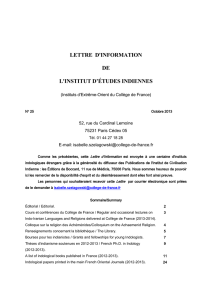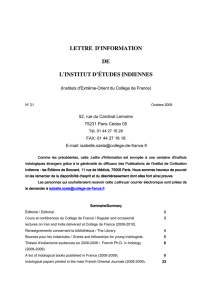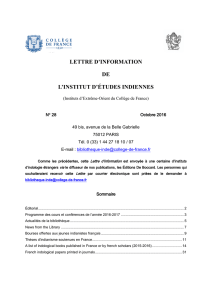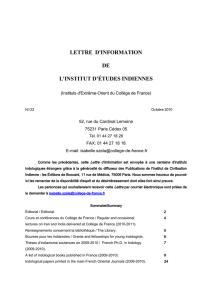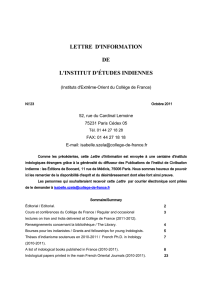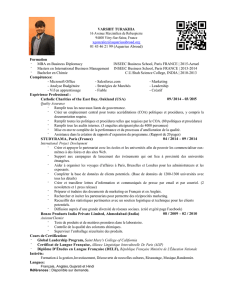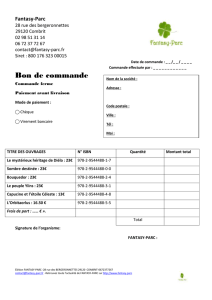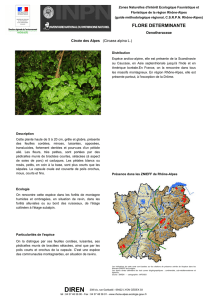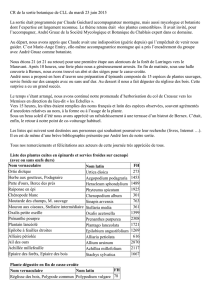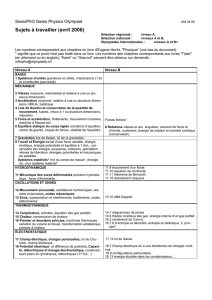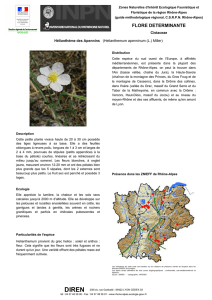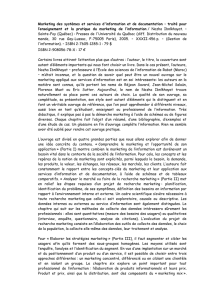lettre d`information
publicité
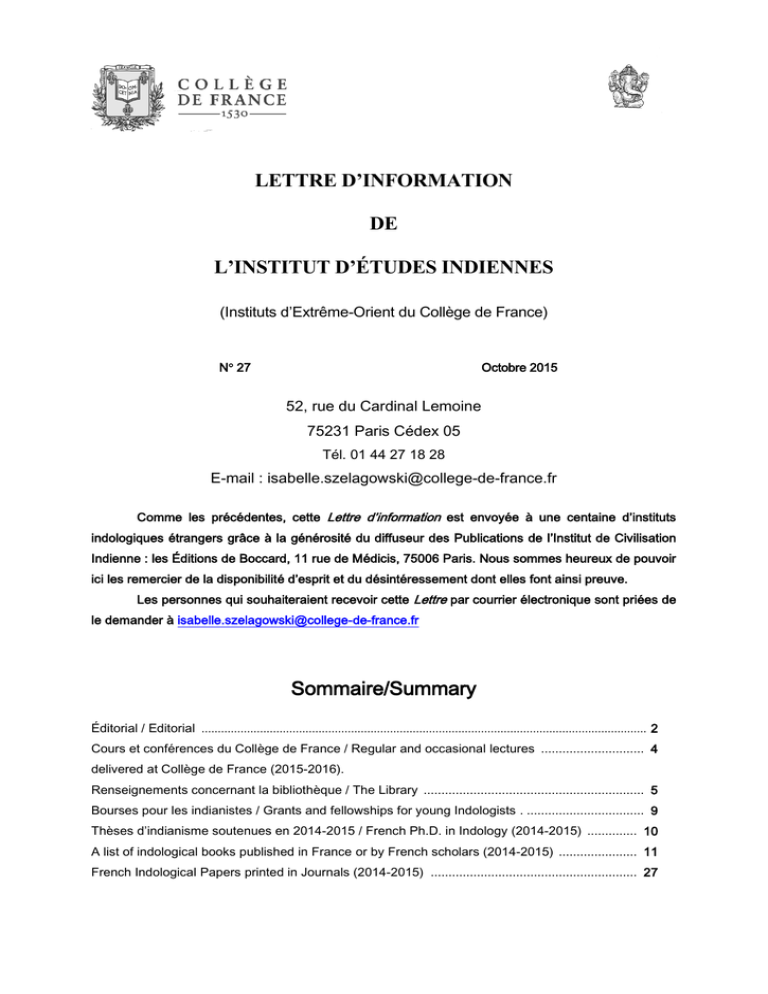
LETTRE D’INFORMATION DE L’INSTITUT D’ÉTUDES INDIENNES (Instituts d’Extrême-Orient du Collège de France) N 27 Octobre 2015 52, rue du Cardinal Lemoine 75231 Paris Cédex 05 Tél. 01 44 27 18 28 E-mail : [email protected] Comme les précédentes, cette Lettre d’information est envoyée à une centaine d’instituts indologiques étrangers grâce à la générosité du diffuseur des Publications de l’Institut de Civilisation Indienne : les Éditions de Boccard, 11 rue de Médicis, 75006 Paris. Nous sommes heureux de pouvoir ici les remercier de la disponibilité d’esprit et du désintéressement dont elles font ainsi preuve. Les personnes qui souhaiteraient recevoir cette Lettre par courrier électronique sont priées de le demander à [email protected] Sommaire/Summary Éditorial / Editorial ......................................................................................................................................... 2 Cours et conférences du Collège de France / Regular and occasional lectures ............................. 4 delivered at Collège de France (2015-2016). Renseignements concernant la bibliothèque / The Library .............................................................. 5 Bourses pour les indianistes / Grants and fellowships for young Indologists . ................................. 9 Thèses d’indianisme soutenues en 2014-2015 / French Ph.D. in Indology (2014-2015) .............. 10 A list of indological books published in France or by French scholars (2014-2015) ...................... 11 French Indological Papers printed in Journals (2014-2015) .......................................................... 27 Lettre d’information de l’Institut d’Études Indiennes, n° 27, octobre 2015 2 Éditorial L’année écoulée a été principalement occupée par la préparation du projet des locaux rénovés (travaux prévus à partir de l’été 2016, en principe pour deux ans), ainsi que du relogement provisoire sur le site de la Belle Gabrielle à Nogent-sur-Marne. Les bibliothécaires de l’IEI ont activement participé aux discussions avec le cabinet d’architecte. Il est certain que le transfert de nos collections et de nos personnels sur un site assez éloigné ne facilitera pas nos activités ; tout au moins les demandes de CDD que nous avions présentées pour aider dans la période délicate du déménagement ont-elles été satisfaites. À l’horizon 2018/2019 nous devrions obtenir une salle de lecture élargie, le déploiement d’une partie des collections en accès libre, et un accroissement des rayonnages en magasins. La proposition par l’Université Lyon-2 d’accueillir une partie de nos doublons afin de compenser l’incendie dont sa bibliothèque avait été victime en 1999 a opportunément rencontré le besoin où nous nous trouvions d’alléger nos réserves. Le tri a été effectué au 1er semestre 2015, la mise en cartons est achevée, et le transfert physique devrait s’opérer en octobre. Le rétrocatalogage des ouvrages en langues asiatiques, financé par le Labex PSL, s’est poursuivi. Peuvent être désormais consultés dans le catalogue les fonds en sanskrit, hindi, pāli (tous systèmes d’écriture confondus), bengali, russe. Le catalogage des reliquats en tamoul devrait être achevé avant la fin 2015. Ces notices sont versées dans le catalogue du Collège ainsi que dans le catalogue interuniversitaire SUDOC. Des contacts ont été pris avec l’ABES pour que l’intégralité du catalogue de la bibliothèque soit versée dans le SUDOC courant 2016. Deux précieux manuscrits sur ôles ont été restaurés grâce à des crédits de mécénat : l’Aṣṭasāhasrikā-Prajñāpāramitā (XIe siècle) et le Śivadharma (XVe siècle). La numérisation par une société spécialisée dans la numérisation des documents patrimoniaux fragiles aura lieu à l’automne 2015. Des demandes de financement sont en cours pour la numérisation de la collection de photographies sur plaques de verre de Sylvain Lévi (photos de l’Inde, du Cambodge, du Népal, prise entre 1897 et 1927, fondation de la Maison francojaponaise de Tokyo). Dans le cadre de l’Institut des Civilisations, nous avons obtenu un poste d’ingénieur « mutualisé » pour aider à la préparation des publications, en remplacement d’Isabelle Szelagowski. Pour notre propre collection, cette année a été une « année blanche », aucun manuscrit n’ayant finalement été retenu par les évaluateurs. Il est prévu de soumettre d’autres manuscrits à partir de la fin de 2016, avec un élargissement des thèmes à l’Asie centrale. Lettre d’information de l’Institut d’Études Indiennes, n° 27, octobre 2015 3 Du point de vue de l’enseignement au Collège, l’absence depuis maintenant quatre ans d’une chaire d’indologie, situation inédite, est évidemment préoccupante. Une réflexion est engagée parmi les collègues de l’Institut des Civilisations pour susciter une candidature susceptible de rallier les suffrages, et il faut espérer que ce processus aboutira dans un délai pas trop éloigné. Dans l’immédiat, les autres chaires orientalistes s’efforcent de maintenir la flamme des études indiennes. Le Collège a accueilli le 25 juin sur le site Cardinal Lemoine une journée d’études en complément au colloque de la BNF sur le bicentenaire de la chaire de sanskrit. Par ailleurs, le 11 décembre 2014, le Pr. Vincent Eltschinger (Académie des Sciences d’Autriche) a donné une conférence sur « Vices, menaces et impiété : sur le Kaliyuga des Bouddhistes ». Il a depuis été élu Directeur d’études à l’École Pratique des Hautes Etudes (Section des sciences religieuses). Frantz Grenet Lettre d’information de l’Institut d’Études Indiennes, n° 27, octobre 2015 4 Chaire d’Histoire et culture de l’Asie centrale préislamique Programme des cours et conférences de l’année 2015-2016 (www.college-de-france.fr) Tous les cours auront lieu 11 Place Marcelin-Berthelot. Histoire et culture de l’Asie centrale préislamique, M. Frantz Grenet, Professeur : Cours : « Le fait urbain dans l’Asie centrale préislamique. Approche synchronique, approche diachronique (suite) : La crise urbaine et la réurbanisation (IIIe-VIe s.), un processus général ? ». Début des cours : 11 février 2016. Dernier cours : 14 avril 2016. Les jeudis de 15h30 à 16h30, Amphithéâtre Maurice Halbwachs. Séminaire : « Mariage et maisonnée d’après les documents en moyen-iranien oriental ». Séminaire combiné avec ceux d’Étienne de la Vaissière (EHESS) et Samra Azarnouche (EPHE) sur le même thème. Début du séminaire : 12 février 2016 Dernier séminaire : 27 mai 2016. Les vendredis de 10 h à 12 h, Cardinal Lemoine, salle Louis Massignon. * Cours à l’étranger : Académie des Sciences de Vienne, quatre cours en janvier (dates à préciser) : « New perspectives on the origins of the Fire Temples : recent archaeological discoveries in pre-Achaemenid and Achaemenid Central Asia » ; « The Turkish kingdom of Kabul-Zabul (VIIth - IXth c.) : a claim to translatio imperii? ». * Conférenciers invités : Yutaka Yoshida (professeur à l’Université de Kyoto) : 3 mai, « Sogdian Buddhists » ; 10 mai, « Yet another Manichaean painting recently discovered in Japan ». Lettre d’information de l’Institut d’Études Indiennes, n° 27, octobre 2015 5 Daniel Potts (professeur à l’Université de New York), invitation conjointe avec la chaire «Techniques et économies de la Méditerranée antique » : 17 mai, « Recent advances in Achaemenid archaeology » ; 24 mai, « Chronological problems of Seleucid Susiana and Elymais » ; 7 juin, « The Persian Gulf as a commercial corridor » ; 17 juin, « Christian monuments in the Persian Gulf ». Antonio Panaino (professeur à l’Université de Bologne-Ravenne) : 22 juin, « Le millénarisme iranien au miroir : origine et circulation d’une idée ». * L’Annuaire du Collège de France publie chaque année le résumé, souvent détaillé, des cours et conférences prononcés par les Professeurs au Collège de France. On peut le commander au Service des Publications du Collège de France, 11 Place Marcelin-Berthelot, 75231 Paris Cédex 05, ou le consulter par internet : www.college-de-france.fr. Ces cours sont aussi téléchargeables via le même site internet. * La bibliothèque La bibliothèque de l’Institut d’Études Indiennes est l’une des cinq bibliothèques des Instituts d’Extrême-Orient du Collège de France. Celles-ci forment un ensemble abrité dans les mêmes locaux et partagent une même salle de lecture. Elles fonctionnent selon le même règlement. La bibliothèque est une composante du pôle Extrême-Orient de l’Institut des Civilisations du Collège de France, membre fondateur du PRES (Pôle de recherche et d’enseignement supérieur) Paris Sciences et Lettres (PSL) labellisé en 2011 comme « Initiative d’excellence (Idex) ». Outil au service de tous les chercheurs, elle est intégrée à l’UMS 2409, Centre de documentation de l’Institut des civilisations du Collège de France, unité mixte de service Collège de France-CNRS. Ces bibliothèques sont ouvertes pour consultation sur place aux enseignantschercheurs et, sur lettre de recommandation, aux étudiants de doctorat, voire de Lettre d’information de l’Institut d’Études Indiennes, n° 27, octobre 2015 6 master si leurs recherches requièrent des fonds spécifiques, propres à la bibliothèque. Les bibliothèques du Collège de France étant réunies depuis le 13 juin 2005 dans un service commun de documentation, les lecteurs s’inscrivent à la bibliothèque de leur choix en remplissant un formulaire d’admission. La carte d’accès à la bibliothèque de l’IEI donne accès à toutes les bibliothèques du Collège de France, ainsi qu’à celle de la Société Asiatique. Les lecteurs sont priés de la garder sur eux car elle peut être demandée à l’entrée du bâtiment et à celle de la salle de lecture. Cette carte permet aussi l’accès à la cartothèque de l’IEI (plans de villes et cartes de l’Inde – sur rendez-vous) et, sur autorisation spéciale, aux archives et à la photothèque de l’IEI, riche de 27 000 clichés numérisés. Un certain nombre de ces clichés sont d’ores et déjà visibles sur le site des archives numériques du Collège de France : Salamandre (https://salamandre.college-de-france.fr/). Le fonds Pakistan, les photographies des collections du musée de Caboul de Dominique Darbois ainsi que la collection d’œuvres d’art, d’objets et statuettes principalement népalais et plusieurs manuscrits sanskrits de la collection Sylvain Lévi peuvent déjà y être consultés dans les meilleures conditions. S’y ajoutent la collection de portraits, principalement de Sylvain Lévi, de l’ancien Institut de Civilisation Indienne de la Sorbonne. Suivront bientôt les photos de paysages et de cérémonies du Népal, et enfin les photos d’Afghanistan des fonds Darbois, Fussman et Le Berre. Par ailleurs, grâce au chantier de conservation mis en place par la bibliothèque, deux manuscrits anciens récemment restaurés, l’Aṣṭasāhasrikā-Prajñāpāramitā (XIe siècle) et le Śivadharma (XVe siècle), vont être prochainement numérisés et mis en ligne sur Salamandre. Pour toute information concernant la consultation de ces fonds, s’adresser aux bibliothécaires (voir infra). L’ensemble du catalogue des bibliothèques des Instituts d’Extrême-Orient est accessible sur le site internet du Collège de France (http://bude.college-de-france.fr). Depuis 2013, les nouvelles acquisitions de l’Institut d’Études Indiennes sont également intégrées au catalogue collectif du Service Universitaire de Documentation (SUDOC, www.sudoc.abes.fr). Le prêt est autorisé aux chercheurs et enseignants-chercheurs statutaires du CEIAS, du CRCAO, de l’EFEO résidant en France, de l’EPHE et de l’UMR 7528 « Mondes iranien et indien ». Il peut être étendu aux autres chercheurs et, dans Lettre d’information de l’Institut d’Études Indiennes, n° 27, octobre 2015 7 certains cas, aux doctorants, sur autorisation du directeur de l’Institut. La durée du prêt est fixée à trois mois, éventuellement renouvelables, à condition que l’ouvrage ne soit pas réclamé entre-temps par un autre lecteur. La salle de lecture commune aux bibliothèques d’Extrême-Orient est normalement ouverte sans interruption de 10 heures à 18 heures, du lundi au vendredi, toute l’année sauf pendant le mois d’août (ouverture de la salle de 14h à 18h uniquement) et pendant les vacances scolaires de Noël (fermeture complète des bibliothèques). Le manque de personnel, consécutif à la suppression début 2004 des postes de CES-CEC-magasiniers, nous oblige à limiter la délivrance d’ouvrages aux utilisateurs de la bibliothèque, que ce soit pour le prêt ou la lecture sur place, aux mardi, mercredi, jeudi et vendredi, à raison de trois levées des demandes de consultations à 14h30, 15h30 et 17h. Ces horaires peuvent être temporairement modifiés pour tenir compte d’absences de personnels ou de travaux en cours, ainsi que pendant les congés. En cas de doute et pour toute demande d’information, vous pouvez contacter les bibliothécaires au 01 44 27 18 10 ou au 01 44 27 18 07, ou par courriel : [email protected] Les ressources numériques (revues en ligne, e-books, bases de données, etc.) du Collège de France (http://bude.college-de-france.fr:8331/V?RN=141844254) sont accessibles via le réseau WIFI de la salle de lecture. Par ailleurs, le portail des ressources numériques offre le référencement d’un ensemble de ressources libres d’accès disponibles également en dehors de la bibliothèque (pour les visionner, sélectionner l’onglet « catégorie » puis dans le menu catégorie cliquer sur le mot « Inde » puis sur « go ») : http://bude.college-defrance.fr:8331/V/EXT5UJ2NINTIKC12TI12CF4KENCE431HXF7JSV6HFNDNXGK6B 3-01865?func=find-db-1&mode=category Les lecteurs inscrits reçoivent désormais régulièrement par courriel la liste des récentes acquisitions de la bibliothèque. Ils peuvent aussi, sur simple demande, recevoir une ou plusieurs des listes de diffusion plus ciblées sur certains sujets qui peuvent les intéresser plus particulièrement : “Nouvelles publications dans le domaine de l’indologie”, “Cours et Séminaires”, “Colloques et Conférences”, “Soutenance de thèses”, “Offres d’emploi”. Lettre d’information de l’Institut d’Études Indiennes, n° 27, octobre 2015 8 The Library The Library of the Institute of Indian Studies is housed in the same building as the libraries of the other Far Eastern Institutes of the Collège de France, 52 rue du Cardinal Lemoine, 75005 Paris, 1st floor (Metro: Cardinal Lemoine). The Reading Room is shared by the Institutes of Indian, Chinese, Japanese, Tibetan and Korean Studies. The Library is reserved for scholars, researchers and graduate students. The Reading Room is open on weekdays from 10 a.m.- 6 p.m. Opening hours may be modified during the holidays or for repair work, etc. Due to a shortage of staff, books are delivered only on Tuesday, Wednesday, Thursday and Friday afternoons, with three rounds of requests for consultations at 2:30 p.m., 3:30 p.m. and 5 p.m. For any further information please contact the librarians (Tel.: +33(0)1 44 27 18 10 / +33(0)1 44 27 18 07; e-mail: [email protected]). The catalogue of the Library of the Institute of Indian Studies is available through the Collège de France internet site (http://bude.college-de-france.fr). Since 2013, the new acquisitions of the Library are also incorporated in the collective catalogue available through the SUDOC website (www.sudoc.abes.fr). Part of the collection of photographs and manuscripts have been digitized and are available on the digital library of the Collège de France (http://salamandre.college-de-france.fr): photographs from Pakistan, from the Kabul Museum by Dominique Darbois, a few Sanskrit manuscripts and the collection of art objects, mainly from Nepal, and portraits (photographs) bequeathed by Sylvain Lévi. Other collections will be soon available: photographs from Nepal (landscapes and rituals), from Afghanistan, and two manuscripts recently restored: the Aṣṭasāhasrikā-Prajñāpāramitā (11th century) and the Śivadharma (15th century). * Lettre d’information de l’Institut d’Études Indiennes, n° 27, octobre 2015 9 Bourses offertes aux jeunes indianistes français Pour obtenir une bourse d’études en Inde lorsqu’on est un étudiant français, il est indispensable de consulter régulièrement les sites web concernés. Pour les bourses françaises, on peut consulter le site de Campus France http://www.campusfrance.org, en cliquant sur “appels à candidatures” puis “programmes de recherche”. Cependant il faut signaler que les bourses pour l’Inde en sciences humaines sont absentes des programmes proposés depuis un certain temps. Les bourses attribuées par le gouvernement indien le sont principalement à des étudiants déjà titulaires de masters. Contacter le service culturel de l’Ambassade de l’Inde, 15 rue Alfred Dehodencq, 75016 Paris, 01 40 50 50 95, http://www.amb-inde.fr. Des bourses sont attribuées par le Centre de Sciences Humaines (CSH) de Delhi qui est une unité mixte de recherche MAE-CNRS. Il faut surveiller périodiquement le site du CSH http://www.csh-delhi.com/, rubrique “Opportunities”, notamment entre les mois d’octobre et janvier. Pour obtenir plus d’informations, on peut s’adresser directement au Centre : [email protected]. L’Institut Français de Pondichéry (IFP) peut proposer en cours d’année des bourses d’études doctorales dans les domaines de l’écologie, de l’indologie et des sciences sociales. Ces bourses sont ouvertes aux étudiants souhaitant travailler sur un sujet en relation avec les programmes de recherche de l‘IFP. Pour toutes informations les concernant, il est recommandé de consulter régulièrement les sites : http://www.ifpindia.org/contact-us ou encore http://www.reseau-asie.com : cliquer sur « appels d’offres » puis sur « EmploisBourses-Stages ». On peut aussi envoyer une demande directement à [email protected] ou [email protected]. La date limite de dépôt des dossiers est fixée normalement au 15 mars de l’année en cours mais il vaut mieux le vérifier. Les équipes de recherche institutionnelles du CNRS et de l’Université disposent de crédits pour les doctorants de leur école doctorale. Se renseigner auprès du directeur de thèse ou/et de l’école doctorale. L’EFEO propose également ses propres bourses de terrain dont les conditions sont décrites sur http://www.efeo.fr/base.php?code=150 La prochaine session d’appel à candidatures pour les allocations de terrain de l’EFEO a pour date limite le 30 septembre de l’année en cours (2016) avant midi (heure de Paris), pour un séjour de terrain en Asie à prévoir entre le 1er janvier et le 30 juin de l’année suivante (2017). Pour toute demande d’information complémentaire ou pour signaler un problème relatif à la candidature en ligne, vous pouvez adresser vos messages à [email protected] ou contacter Mme Claire Prillard au (+33 0)1 53 70 18 60. Lettre d’information de l’Institut d’Études Indiennes, n° 27, octobre 2015 10 Des stages de formation linguistique et philologique en tamoul, “Classical Tamil Winter School” (CTWS) et/ou “Classical Tamil Summer Seminar” (CTSS), sont organisés par l’EFEO à Pondichéry chaque année (en février et/ou en août). Pour plus d’informations, consulter le site http://www.efeo.fr/base.php?code=726. Pour tous renseignements complémentaires contactez Eva Wilden : [email protected] et aussi, pour des questions pratiques, Mme Prerana Patel : [email protected] (toujours mentionner “CTWS ou CTSS” en référence). Tout étudiant ou jeune chercheur désireux d’obtenir l’une de ces bourses ou allocations doit au préalable obtenir l’engagement d’une institution indienne ou d’un universitaire indien de l’accueillir, au moins nominalement. L’obligation d’avoir un partenaire indien est impérative. Elle l’est également pour l’obtention d’un visa de recherche. Le gouvernement indien vient de prendre des mesures pour sanctionner les chercheurs qui utiliseraient un visa de touriste pour mener des recherches sur le territoire indien (www.http://timesofindia.indiatimes.com/india/Foreigners-for-research-visa-to-undergo-scrutiny). * Thèses d’indianisme soutenues en France de septembre 2014 à août 2015 Complément à la Lettre d’information, No. 26, octobre 2014 : Le 13 décembre 2013, Mme Eva Szily a soutenu à l’École Pratique des Hautes Études, Ve section (SR), une thèse de doctorat intitulée : « Les mudrâ : théâtralité d’une langue des gestes ». Le jury présidé par le Professeur Amos Fergombé (Université d’Artois), était composé de Mmes Lyne Bansat-Boudon (EPHE, directrice de la thèse), F. Delvoye (EPHE, IVe section [SHP]), S. D’Intino (CNRS), et de MM. Y. Codet (Université Toulouse-le-Mirail), Ch. Malamoud (EPHE, Ve Section), Heike Moser (Université de Tübingen). Le 7 octobre 2014, M. David Knaute a soutenu à l’EHESS une thèse de doctorat intitulée : « Des Côtes du Gujarat aux pays de la diaspora. Dynamiques identitaires, démographiques et migratoires des communautés parsies de l’Inde et du Pakistan ». Le jury, présidé par M. Boivin (CNRS-EHESS), était composé de Mmes N. Balbir (EPHE, IVe section (SHP) & Université de Paris-3), Cl. Gauthier (Université Bordeaux-2), Aminah Mohammad-Arif (CNRS), C. Servan-Schreiber (INALCO, directrice de la thèse) et de MM. Eric Leclerc (MCF habilité, Département de géographie, Université de Rouen), M.-J. Zins (DR, CNRS). Lettre d’information de l’Institut d’Études Indiennes, n° 27, octobre 2015 11 Le 21 novembre 2014, M. Fabrice Contri a soutenu à l’Université Paris-IV-Sorbonne, Centre Malesherbes, une thèse de doctorat intitulée : « Être compositeur en Inde du sud : le kṛti chez les saints poètes de la Trinité carnatique ». Le jury présidé par M. Nicolas Meeùs (Université Paris-4), était composé de Mme V. Anger (Université d’ Evry) et de MM. L. Aubert (MEG), M. Boivin (DR, CNRS), L. Charles-Dominique (Université Sophia-Antipolis, Nice), D. Negers (INALCO), F. Picard (directeur de la thèse, Paris-4). Le 25 novembre 2014, Mme Fanny Dutillieux a soutenu à l’Université Paris-IV-Sorbonne, à la Maison de l’Asie, une thèse de doctorat intitulée : « La sculpture de l’Himachal Pradesh entre le VIIe et le XIVe siècle ». Le jury présidé par M. Vincent Lefèvre (Université Paris-3), était composé de Mmes E. Parlier-Renault (directrice de la thèse, Paris-4), Ch. Schmid (EFEO, Paris), et de M. O. Bopearachchi (ENS, Paris), Le 28 novembre 2014, M. Fabrizio Speziale a soutenu à l’École Pratique des Hautes Études, Ve section (SR), une habilitation à diriger des recherches (HDR) intitulée : « Culture musulmane et médecine ayurvédique : traduction et changement de deux sciences prémodernes en Asie du Sud ». Le jury, présidé par M. F. Zimmermann (EHESS), était composé de Mme A.-M. Moulin (DR, CNRS), et de MM. P. Lory (tuteur de la thèse, EPHE), M. Boivin (DR, CNRS), J. Houben (EPHE), S. Reichmuth (Ruhr-Universität Bochum), Le 16 février 2015, Mme Vanessa Huguet a soutenu à l’ École des Hautes Études en Sciences Sociales (EHESS) une thèse de doctorat intitulée « Le nationalisme hindou et les usages publics de l’histoire médiévale indienne ». Le jury était composé de Mmes D. Berti (CNRS), C. Lefèvre (CNRS) et de MM. S. Dufoix (Université Paris Ouest Nanterre La Défense), R. Lardinois (CNRS), Cl. Markovits (directeur de la thèse, EHESS), Kapil Raj (EHESS). A list of Indological books published in France or by French scholars (2014-2015) This list has been compiled with the help of the École française d’Extrême-Orient, Laboratoire d’ethnologie et de sociologie comparative (UMR 7535, Maison René Ginouvès, Université Paris X-Nanterre), UMR 8564 (Centre d’Études de l’Inde et de l’Asie du Sud), UMR 7528 (Mondes iranien et indien), EPHE (École Pratique des Hautes Études), UPR 299 du CNRS (Centre d’Études Himalayennes) and the French Institute of Pondicherry. We apologize for any omissions. Lettre d’information de l’Institut d’Études Indiennes, n° 27, octobre 2015 12 Publications de l’École française d’Extrême-Orient Available from École française d’Extrême-Orient, 22, avenue du Président Wilson, 75116 Paris : http://www.efeo.fr. For orders contact [email protected]. Gérard FUSSMAN, Choix d’articles, réunis par D. MATRINGE, E. OLLIVIER, I. SZELAGOWSKI, présentés par G. Fussman. Paris, École française d’Extrême-Orient, collection « Réimpressions », n° 14, 2015, 600 p. Langue : français et anglais. ISBN : 978-285-539-277-6. 40 €. Thirteen G. Fussman’s papers, selected and commented by himself so as to give a kind of overview of his scholarly choices and methods, with uptodate bibliographic supplements, detailed index, curriculum vitae and complete bibliography of the author. Table of contents: « Quelques problèmes aśokéens », 2) « Pour une problématique nouvelle des régions indiennes anciennes », 3) « Documents épigraphiques kouchans (III). L’inscription kharoṣṭhī de Senavarma, roi d’Oḍi : une nouvelle lecture », 4) « Pouvoir central et régions dans l’Inde ancienne : le problème de l’empire maurya », 5) « Symbolisms of the Buddhist Stūpa », 6) « Numismatic and Epigraphic Evidence for the Chronology of Early Gandharan Art », 7) « Nécrologie ― Georges Dumézil (4 mars 1898―11 octobre 1986) », 8) « Cours : Les premiers systèmes d’écriture en Inde », 9) « L’Indo-grec Ménandre ou Paul Demiéville revisité », 10) « Upāya-kauśalya. L’implantation du bouddhisme au Gandhāra », 11) « L’inscription de Rabatak et l’origine de l’ère śaka », 12) « La place des Sukhāvatī-vyūha dans le bouddhisme indien », 13) « The Riddle of the Ancient Indian Eras Is Not Yet Solved » ; Biographie institutionnelle de Gérard Fussman, Bibliographie de Gérard Fussman, Errata et suppléments, Index. www.efeo.fr/fiche_publication.php?code=90&fid=840. * Ch. SCHMID, Sur le chemin de Kṛṣṇa : La flûte et ses voies / On the way with Kṛṣṇa: The flute and its routes. Paris, École française d’Extrême-Orient, collection « Sequens », n° 2, 2014, 168 p., 35 ill. en n&b, cartes. Langue : Français. ISBN : 978-2-85539-446-6. 25 €. The representations of Kṛṣṇa as a flautist are countless and appear as the iconic reference to Kṛṣṇa. The starting point of this study is the association of the melody of the flute and the lifting of the Govardhana Mountain by the god. It represents the encounter between two major streams of the Kṛṣṇadevoted movements: on the one hand, the Govardhana episode attested in Sanskrit texts since the 4th c. and by North Indian sculpted representations since the 5th c.; on the other hand Kṛṣṇa playing the flute, whose origins have never been investigated. The association of the god as a musician with the myth of the lifting up of the Govardhana is linked to the emergence and disseminations of Kṛṣṇa as a flute player, first sculpted in the Tamil country (6th c.). The flute player and the Govardhana lifter appear to have been linked first in the royal Pallava site of Mahābalipuram (6th -8th c.), where they are both represented on the same stone relief depicting the lifting of the mountain by Kṛṣṇa. Lettre d’information de l’Institut d’Études Indiennes, n° 27, octobre 2015 13 Co-publications de l’École française d’Extrême-Orient et de l’Institut Français de Pondichéry Available from the Institut Français de Pondichéry, P.B. 33, 11 St. Louis Street, Pondicherry 605 001: http://www.ifpindia.org/bookstore-list. For orders contact: [email protected]. For the list of other distributors see: http://119.18.62.212/node/11209. Available also from the Pondicherry Centre of the École française d’Extrême-Orient, 16 & 19, Dumas Street, Pondicherry 605 001: for orders contact [email protected] / distributor online: [email protected] / distributor in Chennai: [email protected]. D. ACHARYA (Ed.), Early Tantric Vaiṣṇavism: Three Newly Discovered Works of the Pañcarātra. The Svāyambhuvapañcarātra, Devāmṛtapañcarātra and Aṣṭādaśavidhāna. Critically edited from their 11th- and 12th-century Nepalese palm-leaf manuscripts with an introduction and notes. Collection Indologie n° 129, Early Tantra Series n° 2, Pondicherry, IFP/EFEO/Asien-Afrika-Institut, Universität Hamburg, 2015, lxxxvi, 229 p. ISBN (IFP): 978-818470-206-4; ISBN (EFEO): 978-2-85539-152-6. Language: Sanskrit, English. Rs. 700 (30 €). The three works edited in this volume are hitherto unpublished texts of great significance for the early history of tantric Vaiṣṇavism, for they are probably older than any hitherto published Vaiṣṇava Tantra. The volume ends with indices and facsimiles of the manuscript leaves. * J. DELOCHE, Contribution to the History of the Wheeled Vehicle in India. Collection Indologie n° 126, Pondicherry, IFP/EFEO, 2014, xiii, 145 p. incl. black and white figures and 36 pages of black and white plates. ISBN (IFP): 978-81-8470-201-9; ISBN (EFEO): 978-2-85539-217-2. Language: English. Rs. 700 (30 €). English translation of the author’s Contribution à l’histoire de la voiture en Inde, Publication de l’École française d’Extrême-Orient, vol. CXXXVIII, Paris, EFEO, 1983. After describing carriages presently used in India, their types and geographical distribution, J. Deloche comments on the sources that mention Indian wheeled vehicles from Protohistory to the Mughal period, and the changes introduced by the transport revolution of the middle of the 19th century. * J. DELOCHE, Old Mahé (1721-1817) According to Eighteenth Century French Plans. Pondicherry, IFP/EFEO, 2014, 39 p. Language: English. Rs. 300 (14 €). An introduction to the history of Mahé and an inventory of its lost monuments. Lettre d’information de l’Institut d’Études Indiennes, n° 27, octobre 2015 14 E. FRANCIS, Ch. SCHMID (Eds.), The Archaeology of Bhakti I: Mathurā and Maturai, Back and Forth. Collection Indologie n° 125, Pondicherry, IFP/EFEO, 2014, xiii, 366 p. ISBN (IFP): 978-81-8470-200-2; ISBN (EFEO): 978-2-85539-139-7. Language: English. Rs.1000 (43 €). This volume is the outcome of the first workshop-cum-conference on the “Archaeology of bhakti ” that took place from 1st to 12th August 2011 in the Pondicherry Centre of the EFEO. It focusses on the link between texts and the material world. Contributions: E. Francis & Ch. Schmid, “Introduction: Towards an Archaeology of Bhakti” ; T. Coleman, “Dharma, Yoga, and Viraha-bhakti in Buddhacarita and Kṛṣṇacarita” ; C. Ferrier, “Skanda/Kārttikeya and the Imperial Guptas: Coinage, Religion and Political Ideology (4th -5th century CE)” ; Ch. Schmid, “Bhakti in its Infancy: Genealogy Matters in the Kailāsanātha of Kāñcīpuram” ; Padma Kaimal, “Lakṣmī and the Tigers: A Goddess in the Shadows” ; E. Francis, “ ʻWoe to Them!ʼ: The Śaiva Curse Inscription at Mahābalipuram (7th century CE)” ; A. Dubyansky, “A Medieval Tamil Poem on Bhakti: Tiruppāvai by Āṇṭāḷ” ; S. Anandakichenin, “On the Non-Vālmīkian Sources of Kulacēkara Ālvār’s ʻMini-Rāmāyaṇaʼ ” ; V. Gillet, “When Tradition Meets Archaeological Reality: The Site of Tiruccentūr” ; S.A.S. Sarma, “The Infant Kṛṣṇa in the Guruvāyūr Temple with Particular Reference to the Nārāyaṇīya of Nārāyaṇabhaṭṭa”. * V. GILLET (Ed.), Mapping the Chronology of Bhakti: Milestones, Stepping Stones, and Stumbling Stones: Proceedings of a workshop held in honour of Paṇḍit R. Varadadesikan. Collection Indologie n° 124, Pondicherry, IFP/EFEO, 2014, 381 p. ISBN (IFP): 978-81-8470199-9; ISBN(EFEO): 978-2-85539-138-0. Language: English. Rs. 1100 (48 €). The 11 essays gathered in this volume are dedicated to Paṇḍit R. Varadasikan, a specialist of the Tamil sources of Vaiṣṇavism, who recently retired after a 44-year career in the Pondicherry Centre of the EFEO. Each of the contributions addresses some aspect of the history of the bhakti movement in the South, drawing on a wide range of disciplines –linguistics, philology, epigraphy, archaeology. Contributions : V. Gillet, “Introductory Note” ; S.A.S. Sarma, “Biography and Bibliography of Paṇḍit R. Varadadesikan” ; M. Schmücker, “A Note on Time: Veṅkaṭanātha’s conception of time” ; J.-L. Chevillard, “Metres in Tamil Bhakti Literature and the Problem of their (occasional) Description in Treatises (Studies in Tamil Metrics-2)” ; E. Francis, “Royal and Local Bhakti under the Pallavas” ; T.S. Gangadharan, “Jīvakacintāmaṇi ʼs Contribution to Periyapurāṇam ” ; V. Gillet, “Tracking Traces of Gods: the site of Tirupparaṅkuṉṟam” ; L.C. Orr, “The Sacred Landscape of Tamil Śaivism: Plotting Place in the Realm of Devotion” ; K. Rajan, “Life after Death: From Mortal Remains to Monuments” ; C. Schmid, “The Edifice of Bhakti: Towards an ʻArchaeologicalʼ Reading of Tēvāram and Periyapurāṇam” ; R. Varadadesikan, “Vaiṣṇava Literature in Tamil” ; G. Vijayavenugopal, “From Ancient Poetics to Applied Poetics: Continuance and Change in Tamil Bhakti Poetry (With Special Reference to Nammāḻvār’s akam Poems)” ; E. Wilden, “Nammāḻvār as a Master of tiṇaimayakkam –Transposition Techniques in the akam Lettre d’information de l’Institut d’Études Indiennes, n° 27, octobre 2015 15 Songs of the Tiruvāymoḻi ” ; K. Young, “Śrīvaiṣṇava Topoi: Constructing a South Indian Sect through Place”. * D. GOODALL, A. SANDERSON, H. ISAACSON with contributions of N. KAFLE, D. ACHARYA & others (Eds. & Trs.), The Niśvāsatattvasaṃhitā, The Earliest Surviving Śaiva Tantra. Vol. 1. A critical Edition & Annotated Translation of the Mūlāsūtra, Uttarasūtra & Nayasūtra. Collection Indologie n° 128, Early Tantra Series n° 1, Pondicherry, IFP/EFEO/Asien-Afrika-Institut, Universität Hamburg, 2015, 662 p. ISBN (IFP): 978-81-8470-205-7; ISBN (EFEO): 978-285539-151-9. Language: Sanskrit, English. Rs.1200 (52 €). First edition and English translation of the three earliest layers of the Niśvāsattvasaṃhitā, the oldest surviving complete scripture of the Mantramārga. Link to IFP website: www.ifpindia.org/node/12287. * C. KISS (Ed. & Tr.), The Brahmayāmalatantra or Picumata. Volume II. The Religious Observances and Sexual Rituals of the Tantric Practitioner: Chapters 3, 21, and 45. A critical edition and annotated translation, Collection Indologie n° 130, Early Tantra Series n° 3, Pondicherry, IFP/EFEO/Asien-Afrika-Institut, Universität Hamburg, 2015, 373 p. ISBN (IFP): 978-81-8470-207-1; ISBN (EFEO): 978-2-85539-153-3. Language: Sanskrit (in Roman transliteration), English. Rs. 750 (32 €). The Brahmayāmalatantra or Picumata is probably one of the earliest surviving Śaiva tantras, and possibly the earliest one known to us of the Bhairava tantra tradition. Link to IFP website: www.ifpindia.org/node/12288. * R. SATHYANARAYANAN (Ed. and Tr.), Śaiva Rites of Expiation. A First Edition and Translation of Trilocanaśiva’s Twelfth-Century Prāyaścittasamuccaya (With a Transcription of Hṛdayaśiva’s Prāyaścittasamuccaya). Critically edited & translated by R. Sathyanarayanan with an introduction by D. GOODALL. Collection Indologie n° 127, Pondicherry, IFP-EFEO, 2015, 651 p. ISBN (IFP): 978-81-8470-203-3; ISBN (EFEO): 978-2-85539-218-9. Language: English. Rs. 1200 (52 €). First edition and English translation of a South Indian compendium of Śaiva expiation rituals compiled by Lettre d’information de l’Institut d’Études Indiennes, n° 27, octobre 2015 16 Trilocanaśiva, whose Siddhāntasārāvalī, a metrical treatise on the Śaivasiddhānta, is still traditionally studied in the Tamil-speaking South. A complete transcription of a Nepalese manuscript kept in Cambridge (1157 A.D.) of Hṛdayaśiva’s compendium of expiation rituals is included in the book as an appendix. Link to website: www.ifpindia.org/node/11638. * Ch. SCHMID, La Bhakti d’une reine : Śiva à Tirucceṇṇampūṇṭi. Collection Indologie n° 123, Pondichéry, IFP/EFEO, 2014, ix, 405 p. ISBN (IFP): 978-81-8470-198-2; ISBN (EFEO): 978-285539-137-3. Language: French. Rs. 1100 (48 €). The Tirucceṇṇampūṇṭi Temple built near Trichy in Tamilnadu in the late 9th or early 10th century CE, now abandoned, is one of the earliest known Śaiva temple of the Cōla period. It was dedicated to Śiva “The great god of Tirukkaṭaimuṭi”. The evidence gathered here suggests that it was built in honour of a deity lauded in the Tēvāram (7th -9th centuries), a poetic anthology of the earliest surviving Tamil Śaiva hymns. A Pallava queen, Mārampāvai, whose inscriptions are engraved on pillars found half-buried on the site, was the most prominent among its early patrons. * Publications de l’Institut Français de Pondichéry Available from Institut Français de Pondichéry, P.B. 33, 11 St. Louis Street, Pondicherry 605 001: http://www.ifpindia.org/bookstore-list. For orders contact [email protected]. For the list of other distributors see: http://119.18.62.212/node/11209. BHĀṬṬATANTRARAHASYAM, The Bhāṭṭatantrarahsya of Khaṇḍadeva with the Sāraprakāśikā commentary by N.S. Ramanuja TATACHARYA ; associate editor S. LAKSHMINARASIMHAM. Regards sur l’Asie du Sud / South Asian Perspectives n° 4, Pondicherry, Institut Français de Pondichéry, 2015, xxi, 664 p. ISBN: 978-81-8470-204-0. Language: Sanskrit. Rs. 1200 (52 €). The Bhāṭṭatantrarahasya of Khaṇḍadeva is a 17th c. treatise of Mīmāṃsā, here edited by Prof. R. Tatacharya together with his own Sanskrit commentary. Also included are an index of the Pāṇinian rules, and of the kārikās (citations) and a bibliography. Link to IFP website: www.ifpindia.org/node/12277. * C.S. CHELLAPPA, Vâdivâçal : des taureaux et des hommes en pays tamoul. Récit traduit du tamoul et présenté par François GROS. Regards sur l’Asie du Sud / South Asian Perspectives Lettre d’information de l’Institut d’Études Indiennes, n° 27, octobre 2015 17 n° 3, Pondichéry, Institut Français de Pondichéry, 2014, viii, 113 p. ISBN : 978-81-8470-202-6. Language: French. 450 Rs ((21€). French translation of a famous novelette by C.S.Chelappa, whose subject is the jallikkattu, a traditional Tamilnadu game of bull taming now almost extinct. It focuses on the challenge between an extraordinary bull and the lives and honour of two generations, father and son, of bull tamers. Link to IFP website: http://www.ifpindia.org/node/11627. * M. KANNAN, R. WHITTINGTON, D. SENTHIL BABU and D.C. BUCK (Eds. & Trs.), Time Will Write a Song For You : Contemporary Tamil Writing from Sri Lanka. Regards sur l’Asie du Sud/South Asian Perspectives n° 5, Penguin Books India in association with French Institute of Pondicherry, 2014, xxx, 273 p. ISBN: 978-0-143-42304-1. (Distributed exclusively by Penguin Books) The three decade long conflict tore apart the Tamils’ world in Sri Lanka. This anthology, framed by war, brings together poems, stories and a memoir by Tamil writers living there and in the diaspora. * Co-publications de l’Institut Français de Pondichéry et du Centre de Sciences Humaines (CSH) The Working Papers of the USR 3330 are published online and are freely downloadable from the following page: http://halshs.archives-ouvertes.fr/ R. BHUVANESWARI, M. PRASAD-ALEYAMMA, R. DE BERCEGOL, E. DENIS, M.-H. ZÉRAH, Selected Readings on Small Town Dynamics in India. Pondicherry-New Delhi, IFP / CSH, USR 3330 “Savoirs et Mondes Indiens”, Working Papers Series n° 7, SUBURBIN Papers Series n° 2, 2015, 114 p. See https://hal.archives-ouvertes.fr/hal-01139006. * S. ROUMEAU, A. SEIFELISLAM, S. JAMESON, L. KENNEDY, Water Governance and Climate Change Issues in Chennai. Pondicherry-New Delhi, IFP / CSH, USR 3330, “Savoirs et Mondes Indiens”, Working Papers Series n° 8, 2015, 30 p. See https://hal.archives-ouvertes.fr/hal-01144122. Lettre d’information de l’Institut d’Études Indiennes, n° 27, octobre 2015 18 Publications du CSH, New Delhi Available from the Centre de Sciences Humaines, 2 Aurangzeb Road, New Delhi 110011. E-mail: [email protected] ; Website: http://www.csh-delhi.com ; CSH Occasional Papers can be downloaded for free on the CSH website as well as scholarly articles, news and Interviews: click on “Research & Publications”. R. de BERCEGOL and S. GOWDA, Small and medium-sized towns in India on the fringes of urban development, New Delhi, CSH, 2014. R. de BERCEGOL, Petites villes et décentralisation en Inde. Préface de Marie-Hélène Zérah. Presses Universitaires de Rennes, Domaine : Sciences humaines et sociales / Géographie, collection « Espace et Territoires », 2015, 296 p., ill. couleurs et noir et blanc. ISBN : 978-27535-3619-7. 20 €. These books examine the results of the 1992 decentralization laws in small towns of India. * V. SOLANKI, Forward and Backward Linkages of Migrants to Slums in Delhi, CSH, 2014. Also published in the Indian Journal of Regional Science, Vol. XLVI, No. 1, 2014. * Other Publishers Anand AMALADASS & Ines G. ZUPANOV (eds.), Intercultural Encounter and the Jesuit Mission in South Asia (16th-18th centuries). Bangalore: Asian Trading Organization, 2014, 396 p. ISBN: 978-81-7086-690-9. Rs. 595. A collection of essays by, among others, Ines G. Zupanov, “Prologue: Perils of Translation, Missionary Writing in/on South Asia 16th -18th c.”, p. 1-21 ; G. Colas and Usha Colas-Chauhan, “Une pensée en morceaux. Two Works from the Carnatic Mission: A Refutation of Metempsychosis in Sanskrit and a Collection of Sermons in Telugu”, pp. 62-83 ; Ines G. Zupanov, “Jesuit Proselytism versus Resilient Religious Pluralism: Two South Indian Missions in the 16th and 17th centuries”, pp. 199-231. Complete table of contents on http://ceias.ehess.fr/index.php?3426. * Lettre d’information de l’Institut d’Études Indiennes, n° 27, octobre 2015 19 J.-L. BACQUÉ-GRAMMONT, P.-S. FILLIOZAT et M. ZINK (éd.), Migrations de langues et d’idées en Asie. Actes du colloque international organisé par l’Académie des Inscriptions et Belles Lettres (AIBL), la Société Asiatique et l’INALCO, les 17 et 18 février 2012. Paris, Académie des Inscriptions et Belles Lettres (AIBL), Diffusion De Boccard, 2015, 214 p., 10 illustrations. 26 €. This volume contains four papers concerning India: D. Goodall, “Les influences littéraires indiennes dans les inscriptions du Cambodge : l’exemple d’un chef-d’œuvre inédit du VIIIe siècle (K. 1236) » ; P.-S. Filliozat, « De l’épopée à la métaphysique : le destin du Rāmāyaṇa dans la littérature sanscrite » ; A. Taha-Hussein Okada, « Le Râmnâma ou Livre de Râma : les manuscrits illustrés du Rāmāyaṇa à la cour de l’empereur moghol Akbar (r. 1556-1605) » ; A. Toumarkine, « La description de l’hindouisme et du bouddhisme dans les “Histoires des religions” publiées dans l’Empire Ottoman finissant et en Turquie (fin du XIXe siècle - années 1930) » ; Dejanirah Couto, « Aventurier, passeur de culture et diplomate : Diogo de Mesquita au Gujarat (1529-1535) ». The complete table of contents is available on www.aibl.fr/publications/actes-de-colloque/. * N. BALBIR, M. SZUPPE (ed.), Lecteurs et copistes dans les traditions manuscrites iraniennes, indiennes et centrasiatiques / Scribes and Readers in Iranian, Indian and Central Asian Manuscript Traditions. Roma, Istituto per L’Oriente Carlo Alonso Nallino, Eurasian Studies, vol. XII, 1-2, 2014, 586 p., ill. b/n, I-XXVI planches couleurs (entre p. 578 et p. 579). ISBN : 978-88-97622-20-8 ; ISSN : 1722-0750. 80 €. 23 contributions. Those dealing with India or the Indian world more specifically are: Nalini Balbir, “Réseaux religieux et familiaux dans les colophons des manuscrits jaina de l’Inde occidentale” ; Bruno Dagens, Thiagarajan Ganesan, “Transmission of manuscripts, rewriting and interpretation: the case of the Śaivāgamas in South India” ; Arlo Griffiths, Alexander Lubotsky, “Paippalādasaṃhitā 4.14. Removing an arrow-tip from the body” ; Thibaut d’Hubert, “La diffusion et l’usage des manuscrits bengalis dans l’est du Bengale, XVIIe-XXe siècles” ; Corinne Lefèvre, “Le livre en acte à la cour moghole : le cas des littératures historique et religieuse d’après le Majālis-i Jahāngīrī (1608-1611)” ; Jérôme Petit, “Les savants occidentaux, lecteurs et (re)copistes des manuscrits orientaux : Eugène Burnouf, Léon Feer, Julien Vinson” ; Michaël Peyrot, “La relation entre la chronologie du tokharien B et la paléographie” ; George-Jean Pinault, “Rédacteurs et copistes de textes tokhariens” ; Peter Skilling, “Birchbark, Bodhisattvas, and Bhānakas: Writing materials in Buddhist North India” ; Ingo Strauch, “Looking into water-pots and over a Buddhist scribe’s shoulder : On the deposition and the use of manuscripts in early Buddhism”. Complete table of contents available on: www.aseq.it/eurasian-studies-vol-xii-1-2-2014.html. * Lettre d’information de l’Institut d’Études Indiennes, n° 27, octobre 2015 20 Cl. BAUTZE-PICRON, The Forgotten Place: Stone Images from Kurkihar, Bihar. First Edition, New Delhi, Archaeological Survey of India, 2015, xxviii+644 p., (9) pls., (378) col. Illus., (1) map. US $ 99,95. A detailed study of the stone images found in Kurkihar (9th to 11th c.) now on display in the Kolkata Indian Museum, the State Museum of Lucknow and the British Museum or still worshipped in the temple of the village. Their study helps to define the characteristics of the local stylistic idiom, and to recognize it in images recovered in various other sites of Bihar, Bengladesh and beyond. * D. BERTI, A. GOOD, G. TARABOUT, (ed.), Of Doubt and Proof. Ritual and Legal Practices of Judgment. London, Ashgate, [2015], 220 p. £ 70. 00. By putting ritual and judicial settings into comparative perspective, in contexts as diverse as Indian and Taiwanese divination and international cricket, as well as legal processes in France, UK, India, Denmark, and Ghana, this book offers a comprehensive and new perspective on techniques for casting and dispelling doubt, and the roles they play in achieving verdicts or decisions that appear both valid and just. Papers related to India: Daniela Berti, “Technicalities of doubting: temple consultations and criminal trials in India”; Gilles Tarabout, “Religious uncertainty, astrology and the courts in South India”. Also two chapters concern the migrants from South Asia, mainly Tamils of Sri Lanka: V. Bouillier, “Doubt in action: the different times of doubt in French Assize courts”; A. Good, “ ‘The benefit of the doubt’ in British asylum claims and international cricket”. Table of contents available on http://ceias.ehess.fr/index.php?3452. * M. BOIVIN, Le Pakistan et l’Islam. Anthropologie d’une république islamique. Paris, l’Harmattan, L’Islam en débats, 2015, 226 p. ISBN : 978-2-36085-064-8. 22 €. Version numérique (Pdf texte) 16,99 €. http://www.editions-harmattan.fr/index.asp?navig=catalogue&obj=livre&no=46557. A study of Islam in Pakistan. * O. BOPEARACHCHI, From Bactria to Taprobane: Selected Works of Osmund Bopearachchi. Vol. 1: Central Asian and Indian numismatics. New Delhi, Manohar Publishers & Distributors, 2015, xiii, 701 p., several col. & b&w pls. ISBN: 978-93-5098-069-9. Rs. 3,500 (US $ 74,50). Vol. 2: Art History and Maritime Trade. New Delhi, Manohar Publishers & Distributors, 2015, xiii, 466 p., several col. & b&w pls. ISBN: 978-93-5098-070-5. Rs. 3,000 (US $ 66.00). Lettre d’information de l’Institut d’Études Indiennes, n° 27, octobre 2015 21 Vol.1: English translation of 36 articles on pre-Bactrian, Graeco-Bactrian, Indo-Greek, Indo-Parthian and Kushan numismatics. Also 3 articles on the destruction of Afghanistan’s cultural heritage during the Civil War. Vol. 2: English translation of 18 articles and monographs on Central Asian and Indian art, South Indian and Sri Lankan art and maritime trade in the Indian Ocean. * Th. de BRUIJN, A. BUSCH, (Eds.), Culture and Circulation: Literatures in Motion in Early Modern India. Leyden, Brill, 2014, xii, 316 pp., ill., (Brill’s Indological Library, ISSN: 09252916, Vol. 46). ISBN 13: 9789004264472 ; E-ISBN: 9789004264489, Collections: Asian Studies E-Books Online, Collection 2014. 125 €. A collection of papers including two by French scholars: Thibaut d’Hubert, “Pirates, Poets, and Merchants: Bengali Language and Literature in Seventeenth-Century Mrauk-U”, pp. 47-74 ; Corinne Lefèvre, “The Court of ʻAbd-ur-Raḥīm Khān-i Khānān as a Bridge between Iranian and Indian Cultural Traditions”, pp. 75-106. See http://www.brill.com/products/book/culture-and-circulation. * P. CALLIERI, Architecture et représentations dans l’Iran sassanide. Louvain, Peeters, 2014, Cahiers de Studia Iranica, 50 (2014), 298 p. ISBN : 978-2-910640-36-1. 50 €. Five lectures on Sasanian architecture and iconography delivered in Paris for the 2014 Yarshaters’ Iranian Studies Conferences. * A. CANTERA, Vers une édition de la liturgie longue zoroastrienne : Pensées et travaux préliminaires. Paris, publié par l’Association pour l’Avancement des Études Iraniennes avec le concours du Collège de France, Studia Iranica. Cahier 51, 2014, 429 p. 14 Figs. couleurs. ISBN : 978-2-910640-37-8 ; ISSN : 0993-8699. Diffusion Peeters, Leuven, Belgique. 70 €. Through a thorough study of Indian and Iranian manuscripts, the author shows that there were two different traditions, Indian and Iranian, in the transmission of Avesta. For the first time, we can compare in detail the long liturgy in those two distinct traditions, and analyze the nature and the range of their differences. This should lead to a new edition of the long liturgy. Table of contents: www.peeters-leuven.be/toc/9782910640378.pdf. * A. COUTURE, Kṛṣṇa in the Harivaṁśa. Vol. 1: The Wonderful Play of a Cosmic Child . New Delhi, D.K. Printworld (P) Ltd. (E-mail: [email protected] Website: www.dkprintworld.com), 2015, viii, 362 p., Bibliography, Indices. ISBN : 978-81-246-0824-1. Rs. 990 ; US $ 40.00. Lettre d’information de l’Institut d’Études Indiennes, n° 27, octobre 2015 22 A selection of 13 previously published papers by the author on Kṛṣṇa in the Harivaṁśa, some of them translated from the original French, most of them updated. * A. COUTURE & Ch. CHOJNACKI, Kṛṣṇa et ses métamorphoses dans les traditions indiennes : Récits d’enfance autour du Harivaṃśa. Paris, Presses de l’Université Paris Sorbonne (PUPS : http://pups.paris-sorbonne.fr), collection « Religions dans l’histoire », 2014, 454 p. ISBN : 978-2-84050-953-0. 24 €. A look into stories about Kṛṣṇa when a child in Hindu, Buddhist and Jaina texts (2nd to 10th c. A.D.). * C. FERRIER, L’Inde des Gupta (IVe-VIe siècle). Paris, Les Belles Lettres, collection « Histoire », 2015, 399 p., une carte. ISBN : 978-2-251-38128-2. 29,50 €. An enlarged history of the Gupta Empire (Ph.D. of Paris-IV University). * V. FILLIOZAT, La mythologie hindoue, Tome I : Viṣṇu. Paris, Éditions Āgamāt, 2014, 286 p., 70 ill. en couleur. ISBN : 978-2-911166-33-4. 25 €. A well-illustrated book on Viṣṇu myths. A second volume will be devoted to the stories of Śiva. * GANDHI, Hind Swaraj, l’émancipation à l’indienne, traduit du goujarati, de l’anglais et du hindi par ANNIE MONTAUT. Édition établie par Suresh Sharma et Tripid Suhrud. Préface de Charles Malamoud. Introduction par Suresh Sharma. Paris, Éditions Fayard, collection « Poids et Mesures du Monde », 2014, 224 p. ISBN 9782213682013. 18 €. Ce livre existe en version numérique : ISBN ebook : 9782213687841, 12,99 €. French translation from the original 1909 Gujarati edition of Gandhi’s book on swaraj (autonomy, independence). * F. GRENET, Recentrer l’Asie Centrale. Leçon inaugurale n° 239 du Collège de France. Paris, Collège de France / Éditions Fayard, 2014, 72 p. ISBN : 9782213681436 ; ISBN (électronique): 9782722603288 ; 10,20 €. Ce livre existe en version électronique sur le site : http://books.openedition.org/cdf/3590 Inaugural lecture delivered on November 7th 2013 by F. Grenet appointed Professor at the Collège de France (chair of History and culture of pre-islamic Central Asia). Lettre d’information de l’Institut d’Études Indiennes, n° 27, octobre 2015 23 I. GUÉRIN, La microfinance et ses dérives : émanciper, discipliner ou exploiter ? Paris, Démopolis, 2015, 298 p. ISBN : 978-2-35457-049-1. 23 €. A critical study of microfinance and its effects in Asia, including Bangladesh and India. * HĀLA, « Tu l’aimes, je t’aime. ». Poèmes de l’Inde ancienne traduits du prakrit par Nalini BALBIR. Paris, Presses de la Sorbonne Nouvelle, 2015 (Cahiers de poésie bilingue n° 2), 68 p. ISBN : 978-2-87854-662-0. 8 €. Introduction and French translation of 160 stanzas from Hāla’s Sattasaī. * M. HULIN, Sept récits initiatiques tirés du Yoga-Vâsistha. Traduits du sanskrit avec introduction et notes par Michel Hulin. Paris, Berg International, 2015 (Nouvelle édition, 1re ed. 1987), 195 p. ISBN : 978-2-37020-045-7. 19 €. New edition of the first French translation of these seven initiatory stories from the Yoga-Vâsistha. * C. JAFFRELOT (dir.), L’Inde contemporaine. Paris, Fayard, collection de Poche « Pluriel », 2014, 336 p. ISBN : 9782818503461. 9,00 €. New revised and enlarged edition with seven new chapters of a description of today India. * JÑĀNAPRAKĀSHA, Shiva-yoga-ratna, Le joyau du yoga shivaïte. Introduction, traduction et notes de Tara MICHAËL. Paris, Éditions Almora, 2014, 144 p. Réf. V00108. 17 €. French translation of a 16th c. South Indian Yoga treatise. The original text is reproduced at the end of the book. * L. KENNEDY, R. JENKINS, P. MUKHOPADHYAY (ed.), Power, Policy, and Protest: The Politics of India’s Special Economic Zones. New Delhi, Oxford University Press, 2014, 396 p. ISBN: 9780198097341. Rs. 1.145,00 (₤ 35,99). Collected papers on the protestations in eleven Indian states where SEZs (Special Economic Zones), were proposed. L. Kennedy is a member of the CEIAS in Paris. Table of contents available on http://ukcatalogue.oup.com/product/9780198097341.do. Lettre d’information de l’Institut d’Études Indiennes, n° 27, octobre 2015 24 L. KENNEDY, The Politics of Economic Restructuring in India: Economic governance and State Spatial Rescaling. London, Routledge Contemporary South Asia Series, 2014, 192 p. ISBN : 978-0-415-82282-4. ₤85,00. http://ceias.ehess.fr/index.php?2753 * C. LAPLANTINE et G.-J. PINAULT (éds.), É. Benveniste, Langues, cultures, religions. Choix d’articles réunis par Chloé Laplantine et Georges-Jean Pinault. Limoges, Éditions LambertLucas, 2015, 380 p. ISBN : 978-2-35935-099-9. 30 €. A selection of little known articles by the linguist Émile Benveniste, several of which dealing with Sanskrit, preceded by a detailed Introduction. Complete list of the articles: www.lambert- lucas.com/langues-cultures-religions. * C. LE BLANC, Les Livres de l’Inde : une littérature étrangère en France au XIXe siècle. Paris, Presses Sorbonne Nouvelle, 2014, 236 p. ISBN : 978-2-87854-636-1. 21,50 €. A study of the reception of books written in Indian languages in 19th c. France. * K. LÉGERET (dir.), Rodin et la danse de Çiva. Paris, Presses Universitaires de Vincennes et Musée Rodin, 2014, 243 p., nombreuses ill. noir et couleur. ISBN : 978-2-84292-395-2. 25 €. In 1911 Rodin received from Victor Goloubeff 27 photographs of bronze sculptures of Śiva Naṭarāja in the Madras (now Chennai) Museum. Rodin drafted then a text published after his death in 1912 and reprinted in 1998. This book is a second reprint and adds the proceedings of a workshop held on October 17th, 2012, at the Musée Rodin. * P. LERICHE (dir.), Art et Civilisation de l’Orient hellénisé. Rencontres et échanges culturels d’Alexandre aux Sassanides. Hommage à Daniel Schlumberger. Paris, Éditions Picard (www.editions-picard-com), 2014, 328 p., c. 240 ill. dont 77 planches en couleurs. ISBN : 978-2-7084-0983-5. 65 €. A collection of papers delivered at a UNESCO Colloquium on the hellenistic East held in Paris from 28th to 30th September 2009 at the invitation of P. Leriche. Papers on Greek influences on India by Cr. Scherrer-Schaub, “Le roi indo-grec Ménandre discuta-t-il avec les philosophes bouddhistes ? »,167-171, and Ch. Luczanits, “The diffusion of Gandharan and Indian models in South Asia”, 245-250. * Lettre d’information de l’Institut d’Études Indiennes, n° 27, octobre 2015 25 Cl. MARKOVITS, J.-L. MARGOLIN, Les Indes et l’Europe. Histoires connectées, XVe -XXIe siècles. Paris, Collection Folio Histoire (n° 246), Gallimard, 2015, 976 p. ISBN : 9782070462179. 14,90 €. A connected history of the relations between South and South-East Asia since the 15th c. * J.P.B. MORE, From Arikamedu to the Foundation of Modern Pondicherry. New Delhi, India Munshiram Manoharlal Publishers Pvt. Ltd. 2014, 240 p., ill. ISBN 9788192763927. Rs. 315. A history of Pondicherry till the arrival of the French in 1673-74 and the foundations of modern Pondicherry. * Prithwindra MUKHERJEE, Le Spontané, chants caryā et bāul. Traduction du bengali, présentation et commentaires. Paris, éditions Almora, collection « Almora traductions », 2014, 288 p., 22 €. French translation of caryâ and bâul Bengali songs. * A. PORTE, L’éveil de la conscience ou l’illumination de la reine Tchoudâlâ. Conte inspiré par le Rāmāyaṇa. Traduit du sanskrit, présenté et annoté par Alain Porte. Paris Éditions Dervy, 2015, 167 p. ISBN : 978-10-242-0076-7. 18 €. This Indian tale, part of the 10th c. A.D. (?) Yogavāsiṣṭa, relates the dialogue between king Śikhidhvaja and his wife Cudālā about the possibility of reaching enlightenment in the everyday life, i.e. of conciliating renunciation and daily activities. * J.-L. RACINE, Penser l’Inde émergente : de l’altérité orientaliste au post-colonialisme. Working paper pour la Fondation Maison des sciences de l’homme (FMSH), septembre 2014. This text can be downloaded for free on the FMSH website : http://www.centreasia.eu/publication/racine-fmsh-092014-penser-inde-emergente. * I. RATIÉ, Une Critique bouddhique du Soi selon la Mīmāṃsā. Présentation, édition critique et traduction de la Mīmāṃsakaparikalpitātmaparīkṣā de Śāntarakṣita, Vienne, Verlag ÖAW, 2014, 371 p. (Beiträge zur Kultur- und Geistesgeschichte Asiens 84, Sitzungsberichte der Lettre d’information de l’Institut d’Études Indiennes, n° 27, octobre 2015 26 phil.-hist. Klasser 857). Print Edition: ISBN: 978-3-7001-7665-7 ; Online Edition: 978-3-70017733-3. 55 €. Critical edition, translation and study of 62 Sanskrit verses from the 8th centuryTattvasaṅgraha (222284 and Pañjikā) by Śāntarakṣita and their commentary by Kamalaśīla. Table of contents online http://hw.oeaw.ac.at/7665-7. * S. SUBRAHMANYAM, Leçons indiennes : itinéraires d’un historien, Delhi, Lisbonne, Paris, Los Angeles. Paris, Alma éditeur, 2015, 380 p. ISBN : 978-2-36279-139-0. 25 €. Livre numérique : 17,99 € / EAN13 / 9782362791406. www.alma-editeur.fr/lecons_indiennes.html. A collection of c. 20 papers published by the author and giving an overview of his life and ideas. * Mihaela TIMUŞ, Cosmogonie et eschatology. Articulations conceptuelles du système religieux zoroastrien. Publié avec le concours de la Fondation Simone et Cino Del Duca de l’Institut de France et du Collège de France. Paris, Association pour l’avancement des Études iraniennes, Studia Iranica, Cahier 54, 2015, 288 p. ISBN : 978-2-910640-40-8. Diffusion Peeters, Leuven, Belgique. 30 €. This book includes seven studies that use historiographical and philological methods to explore the historical and religious aspects of Zoroastrian cosmogony and eschatology. The author pays special attention to the French scholarship on this topic, in order to show how the modern history of religions transformed Christian theological concepts in its analysis of the Zoroastrian religion. The author devotes several pages to Anquetil-Duperron and his close relations with the Indian zoroastrian community. The Addenda include several unpublished documents, relevant for the history of Zoroastrian studies in France, e.g. the correspondence between Eugène Burnouf and various Parsis scholars from Bombay (e.g. Manackjee Cursetjee). Table of contents: www.peeters-leuven.be/toc/9782910640408.pdf. * G. TOFFIN and J. PFAFF-CZARNECKA (eds.), Facing Globalization in the Himalayas: Belonging and the Politics of the Self. Delhi: Sage Publications, 2014 (Midea Series: Governance, Conflict and Civic Action, Vol. 5), 484 p. ISBN (ebook): 9789351500483; ISBN (hardcover): 9788132111627, ₤47,50. A collection of papers on changes within the Himalayan societies (Nepal and Republic of India). Table of contents available on: http://www.sagepub.in/books/Book241965?siteId or http://www.uk.sagepub.com/books/Book241965#tabview=toc. Lettre d’information de l’Institut d’Études Indiennes, n° 27, octobre 2015 27 Ines G. ŽUPANOV, A. BARRETO XAVIER, Catholic Orientalism. Portuguese Empire, Indian Knowledge (16th-18th Centuries). New Delhi, Oxford University Press-OUP India, 2015, 416 p. ISBN: 978-0-19-945267-5. £42.99. A chronicle of the rise and decline of the Catholic knowledge of South Asia which had not been, at any point, only and simply “Portuguese”. Table of contents: http://ukcatalogue.oup.com/product/9780199452675.do#. * E.M. WILDEN, Manuscrit, Print and Memory. Relics of the Caṅkam in Tamilnadu. Studies in Manuscript Cultures, Volume 3. Berlin, De Gruyter, 2014, 445 p. ISBN: 978-3-11-034089-1 ; ISBN (PDF): 978-3-11-035276-4 ; ISBN (epub): 978-3-11-038779-7. www.degruyter.com/view/product/246341?rskey=jAu5cc. * French Indological Papers Printed in Journals (2014-2015) Annuaire du Collège de France, (Available from Collège de France, 11, place Marcelin Berthelot, 75231 Paris Cédex 05, 25 €). 114e année, Paris, 2015, Résumés des cours et séminaires 2013-2014, 1086 p. ISBN : 978-2-7226-0414-8. F. Grenet : Le fait urbain dans l’Asie centrale pré-islamique : approche diachronique, approche synchronique, 507-534. J. Kellens : Vingt ans d’études avestiques et mazdéennes, 535-544. * Arts Asiatiques (Annales du Musée National des Arts Asiatiques-Guimet et du Musée Cernuschi). Available from École française d’Extrême-Orient (EFEO), 22, Avenue du Président Wilson, 75116 Paris. E-mail : [email protected] Lettre d’information de l’Institut d’Études Indiennes, n° 27, octobre 2015 28 Tome 69 ― 2014 (paru en janvier 2015), 196 p., ill. (couleur et N/B), 40 €. ISBN : 978-2-85539159-5. Papers concerning India and Greater India: N. Chanchani, “From Asoda to Almora, The Roads Less Taken: Māru-Gurjara Architecture in the Central Himalayas” ; H. Multzer o’Naghten, “Une création iconographique khmère inédite. Vajrapāṇi sur Garuḍa ?”; F. Lagirarde, “Les ho tham du Lanna, bibliothèque des monastères bouddhiques du Nord de la Thaïlande”. Other papers concern China and Corean paintings. DOSSIER : Inscribed cult utensils of ancient Southeast Asia: A. Griffiths & D. Soutif, “Avant-propos / Foreword”; J. Estève & D. Soutif, “Un liṅgakośa inscrit au Musée national du Cambodge (K. 1286)” ; A.-V. Schweyer, “Un liṅgakośa inscrit du Campā ancien (C. 209)” ; A. Griffiths & B. Vincent, “Un vase khmer inscrit de la fin du XIe siècle (K. 1296)” ; A. Griffiths & P. Lunsingh Scheurleer, “Ancient Indonesian Ritual Utensils and their Inscriptions : Bells and Slitdrums”. Short notices on new acquisitions and activities in Guimet, Cernuschi, the State Hermitage Museum (St Petersburg), and the Museum of Far Eastern Antiquities (Stockholm). Book reviews. * Bulletin de l’École française d’Extrême-Orient (Available from EFEO-Diffusion, 22 Avenue du Président Wilson, 75116 Paris. Courriel : [email protected] ) Tome 99 (2012-2013, paru en septembre 2014). ISBN : 978-2-85539-203-5, 456 p., 50€. Langue : Français et Anglais. P. Pichard, “In memoriam / Obituary : Pascal Royère (19652014)” ; Papers concening India and Greater India: P. Gutman & B. Hudson, “A First-Century Stele from Śrikṣetra” ; M. Falser, “The first plaster casts of Angkor for the French métropole: From the Mekong Mission 1866-1868, and the Universal Exhibition of 1867, to the Musée khmer of 1874” ; H. David, “Nouvelles tendances dans l’étude de la Mīmāṃsā. Trois publications récentes sur l’exégèse brahmanique classique”. Book reviews by Ines G. Županov on: P.-S. Filliozat, J.-P. Mahé & J. Leclant (éd.), L’œuvre scientifique des missionnaires en Asie. Journée d’études organisée par l’Académie des inscriptions et belles-lettres et la Société asiatique (Palais de l’Institut de France, 9 janvier 2009) ; by E. Francis on: Patrick Olivelle, King, Governance, and Law in Ancient India: Kauṭilya’s Arthaśāstra, A New Annotated Translation ; Csaba Dezsȍ on: ZHU Xintian, Les êtres fantastiques de l’Inde ancienne. De 2500 av. J.-C. au VIème siècle, Vol. I. ; A. Padoux on: Richard H. Davis, A Priest’s Guide for the Great Festival. Aghoraśiva’s Mahotsavavidhi. Translated with Introduction and Notes ; Cr. Cramerotti on: G. Mikaelian, Un partageux au Cambodge : biographie d’Adhémard Leclère suivie de l’inventaire du Fonds Adhémard Leclère. Other reviews concern China and Japon. * Lettre d’information de l’Institut d’Études Indiennes, n° 27, octobre 2015 29 Bulletin d’Études Indiennes (Association Française pour les Études Indiennes, Instituts d’Extrême-Orient, Collège de France, 52 rue du Cardinal Lemoine, 75231 Paris Cédex 05) N° 31 (2013, paru en mars 2015). 394 p., 30 €. J.A.F. Roodbergen et Jan Houben, “In memoriam S.D. Joshi (1926-2013)”. ARTICLES : S. Brocquet, “La fabrique du double sens dans la poésie sanskrite : l’exemple du Rāghavapāṇḍavīya de Kavirāja” ; Md. Faiz Khan, “Les traductions françaises des nouvelles de Premchand : un regard critique” ; P. Khoroche, “Daṇḍin’s Avantisundarī”; P. Lachaier, “Lohana et autres hindous à Lisbonne : Temples et associations de langue gujarati” ; H. Tieken, “Daṇḍin, the Daśakumāracarita, and the Avantisundarīkathā” ; A. Vigasin, “A Unique Gaṇḍavavyūha Manuscript in Moscow : A Preliminary Report”. VARIA ET NOTES DE LECTURE : Lucas Den Boer, “Perspectivism and Criticism in Vidyānandin’s Satyaśāsanaparīkṣā : Review article” ; P. Lachaier, “Les Patel de Panchavati et les grands marchés de tissus de Railwaypura, Ahmadabad : deux promenades exploratoires” ; P. Lachaier, “Note de lecture sur Harald Tambs-Lyche, Business Brahmins, The Gaud Saraswat Brahmins of South Kanara” ; G.-J. Pinault, “Une nouvelle traduction du Ṛgveda ”. 18 reviews by N. Balbir, S. Brocquet, E. Ciurtin, Jan E.M. Houben, J. Petit, G.-J. Pinault, P. Skiling. N° 32 (2014, parution décembre 2015), 300 p. Préface par E. Aussant et J.-L. Chevillard, “Les études sur les langues indiennes. Leur contribution à l’histoire des idées linguistiques et à la linguistique contemporaine”. E. Aussant, “Sanskrit Theories on Homonymy and Polysemy” ; Tej K. Bhatia, “Early Hindi Grammars: Context and Contributions to Language Study” ; J. Bronkhorst, “Deviant voices in the history of Pāninian grammar” ; M.-P. Candotti & Tiziana Pontillo, “Pāṇini’s zero morphs as allomorphs in the complexity of linguistic context” ; G. Cardona, “Segmentation of Vedic texts: padapāthas” ; J.-L. Chevillard, “On the relative chronology of Tamil grammarians between the age of Tolkāppiyam and the age of Nannūl” ; H. Henrich Hock, “The Relation of the Indian Grammatical Tradition to Modern Linguistics” ; Jan E.M. Houben, “Pāṇinian grammar of living Sanskrit: features and principles of the Prakriyā- Sarvasva of Nārāyaṇa-Bhaṭṭa of Melputtūr” ; Artemij Keidan, “Form, function and interpretation: a case study in the textual criticism of Pāṇini’s Astādhyāyī ” ; Malhar A. Kulkarni, “Franz Kielhorn and the text of the Astādhyāyī as given in the Kāśikāvṛtti : A study-II” ; Peter Raster, “The origin of grammar and the meaning of vyākaraṇa : from classical to non-classical concepts” ; Manfred Ringmacher, “A common concern for Sanskrit: Wilhelm von Humboldt and Franz Bopp in their letters” ; Peter M. Scharf, “The relation between etymology and grammar in the linguistic traditions of early India” ; Vincenzo Vergiani, “The concept of prayokṛdharma in the Vākyapādīya and some later works. The expression of feelings through words: a linguistic and philosophical outlook”; Eva Wilden, “Āciriyappā. The Written and the Unwritten Rules of Classical Tamil Metre” — Autres Articles : S. Brocquet, “Épigraphie et poétique : le virodha dans l’inscription du Lettre d’information de l’Institut d’Études Indiennes, n° 27, octobre 2015 30 temple dit « de Ganeśa » à Mahābalipuram” ; T. Dietrich, “Stylistic Analysis of Coordinative Nominal Constructions for Dual Deities in the Ṛgveda”. ‒ Comptes rendus / Reviews. * Études Epistémè (Revue électronique de Littérature et de Civilisation (XVIe-XVIIIe siècles). Articles en ligne, texte intégral (Pdf), résumé en français et en anglais / Electronic Review of Literature and Civilization, 16th -18th c. Online articles, full text (Pdf), summary in French and English. http://episteme.revues.org/290. N° 26 (2014) : Presses et transferts culturels / Curiosité et géographie. II. Curiosité et géographie en Orient et en Occident, XVIe-XVIIIe siècles : G. Colas, « Curiosité, science et interaction pédagogique : la mission française jésuite et la mission piétiste de Halle en Inde du sud au XVIIIe siècle / Curiosity, science and pedagogic interaction : the French Jesuit Carnatic mission and the Pietist Tranquebar mission in XVIIIth century South India », 24 pages, http://episteme.revues.org/335. C. Lefèvre, « Curiosité et pouvoir : les collections de l’empereur moghol Jahāngīr (r. 1605-1627) / Curiosity and Power : the collections of the Mughal Emperor Jahāngīr (r. 16051627) », 24 pages, http://episteme.revues.org/341. * Indo-Iranian Journal, P.C. Bisschop & J.A. Silk (Eds.), Leiden, Brill, E-ISSN : 1572 - 8536. http://brill.com/indo-iranian-journal Vol. 57, Nos. 1-2 (2014) : V. Tournier, “Mahākāśyapa, His Lineage, and the Wish for Buddhahood: Reading Anew the Bodhgayā Inscriptions of Mahānāman”, 1-60. Among the book reviews: S. D’Intino, pp. 175-182, on Cezary Galewicz, A Commentator in Service of the Empire: Sāyaṇa and the Royal Project of Commenting on the Whole of the Veda (De Nobili Research Library 35), Wien, 2010. Vol. 58, No. 1 (2015) : E. Francis, “Tamil through Epigraphical Lenses”, 49-69 : Review Article on A. Murugaiyan (ed.), New Dimensions in Tamil Epigraphy: Select Papers from the Symposia held at EPHE-SHP, Paris in 2005, 2006 and a Few Invited Papers. Chennai 2012. * Journal Asiatique (Société Asiatique, 23, quai de Conti, 75006 Paris, 85 € (Abonn. : 65 €), http://www.aibl.fr/societe-asiatique/bibliothèque-archives/#. Le JA est disponible en ligne / The JA is available online : http://poj.peeters-leuven.be Tome 301, 2, 2013 (paru en février 2014), VII-335-645 p. Papers related to the Indian subcontinent: R. Moreau, “À dos d’éléphant, du Cachemire aux mines de Golconde : récits de voyageurs européens au XVIIe siècle” ; V. Filliozat, “Une communauté śivaïte du Karnāṭaka révélée par des inscriptions kannaḍa” ; P. Estienne, “Les inscriptions sanskrites des Cālukya Lettre d’information de l’Institut d’Études Indiennes, n° 27, octobre 2015 31 orientaux : matériaux épigraphiques et données historiques” ; M. Polkinghorne, Ch. Pottier, Cr. Fischer, “One Buddha can hide another”. Tome 302, 1, 2014 (paru en Juillet 2014), V-229 p. One paper related to India: Ch. I. Beckwith, “The Aramaic source of the East Asian word for ʻBuddhist monasteryʼ on the spread of Central Asian monasticism in the Kushan period”, 111-138. Tome 302, 2, 2014 (paru en mars 2015), 231-605 p. Papers concerning India and Iran: P.S. Filliozat, “In memoriam / obituary “Kamaleswar Bhattacharya (1928-2014)”, 239-243 ; S.W. Jamison, “The Earliest Evidence for the Inborn Debts of a Brahmin. A New Interpretation of Ṛgveda X.135”, 245-257 ; J. Kellens, “La Gâthâ Ahunauuaitī dans l’attente de l’aube”, 259-302 ; J. Haudry, “Vérité, fausseté et mensonge dans le monde indo-iranien”, 349-364 ; “La politique royale du serment en Inde ancienne, us et abus de la parole donnée”, 365-376. Tome 303, 1, 2015 (à paraître fin 2015), c. 172 p. Papers related to India and Greater India : É. Pirart, “Dieux perses et dieux avestiques”, 47-58 ; M. Minardi, “A Silver Rhyton from Afghanistan Held in the Cleveland Museum of Art and its Historical Context”, 59-86 ; S. D’Intino, “Sacrifice et vérité dans l’Inde védique”, 137-142. Among the book reviews, two are by G. Fussman : pp.165-166, on Annette Schmiedchen, Herrschergenealogie und religiöses Patronat. Die Inschriftenkultur der Rāṣṭrakūṭas, Śilāhāras und Yādavas (8 .bis 13. Jahrhundert) Généalogie royale et patronat religieux : la culture épigraphique des R., Ś. et Y. (8e -13e siècles), Gonda Indolological Studies, vol. XVII, Brill, Leiden 2014 ; pp.166-168, on Harry Falk, Hariśyenalekhapañcāśikā, Fifty Selected Papers on Indian Epigraphy and Chronology, Selected and prepared for publication with indices by Britta Schneider and Ingo Strauch in collaboration with Caren Dreyer and Andrea Schlosser, Hempen Verlag, Bremen 2013 ; André Couture : pp.168, on Charlotte Schmid, Sur le chemin de Kṛṣṇa. La flûte et ses voies, Paris, EFEO, coll. Sequens, n° 2, 2014 ; P.-S. Filliozat : pp.169-170, on Banārasidās, Histoire à demi, autobiographie d’un marchand jaina du XVIIe siècle, traduit du vieil hindi et présenté par Jérôme Petit, Presses Sorbonne Nouvelle, Paris, 2011. * Journal of Indian Philosophy (Published by Springer Link. Available online : http://www.springer.com ; http://www.link.springer.com) Vol. 42, No.1 (March 2014), 247 p. Guest Editors: Lyne Bansat-Boudon, Judit Törzsök. Special Issue on Śaiva Philosophy: L. Bansat-Boudon - J. Törzsök, “Introduction” ; D. Acharya, “On the Śaiva Concept of Innate Impurity (mala) and the Function of the Rite of Initiation” ; P. Bisschop, “Pañcārtha Before Kauṇḍinya” ; L. Bansat-Boudon, “On Śaiva Terminology: some Key Issues of Understanding” ; J. Nemec, “The Evidence for Somānanda’s Pantheism” ; R. Torella, “Utpaladeva’s Lost Vivṛti on the Īśvarapratyabhijñā-kārikā” ; I. Ratié, “A Śaiva Lettre d’information de l’Institut d’Études Indiennes, n° 27, octobre 2015 32 Interpretation of the Satkāryavāda: The Sāṃkhya Notion of Abhivyakti and Its Transformation in the Pratyabhijñā Treatise” ; A. Watson, “The Self as a Dynamic Constant. Rāmakaṇṭha’s Middle Ground Between a Naiyāyika Eternal Self-Substance and a Buddhist Stream of ConsciousnessMoments” ; J. Törzsök, “Nondualism in Early Śākta Tantras: Transgressive Rites and Their Ontological Justification in a Historical Perspective” ; J. Mallinson, “Haṭhayoga ‘s Philosophy: A Fortuitous Union of Non-Dualities”. * Puruṣārtha (Centre d’Études de l’Inde et de l’Asie du Sud, École des Hautes Études en Sciences Sociales, 190-198 avenue de France, 75013 Paris). Available from Éditions de l’EHESS, 131 boulevard Saint-Michel, 75005 Paris. Courriel : [email protected] N° 32 (paru en mai 2014), ISBN EHESS : 978-2-7132-2423-2, 328 p., 29 € : “Indianité et créolité à l’île Maurice / Indianness and Creolity in Mauritius”, edited by Catherine ServanSchreiber : “Introduction” ; A. Carsignol-Singh, “L’Inde et la production de l’indianité à Maurice” ; J. Peghini, “L’ « unité dans la diversité » à Maurice. Un modèle d’inspiration indienne” ; A. GoreauPonceaud, “Y a-t-il un « malaise » tamoul à Maurice ? Entre reconnaissance et dramatisation identitaires” ; E. Grégoire, “Rivalités politiques et économiques dans l’océan Indien. Entre Inde et Chine, le cœur de Maurice balance” ; M. Claveyrolas, “Un prêtre tamoul dans le chantier de l’hindouisme mauricien. Orthodoxies et autorité religieuse” ; P.-Y. Trouillet, “Les lances de Muruga à Maurice. Trajectoires d’un hindouisme tamoul” ; C. Servan-Schreiber, “La fabrique de l’intime à Maurice” ; E. Bruno, J.-F. et Srilata Ravi, “Ethnicité, sexualité et mythologie : Ananda Devi et l’Indomauricianité” ; A. Montaut, “Les monstres d’Ananda Devi. Radioscopie de la folie ou manifeste du dire poétique ?”. VARIA : C. Déodat, “Échos d’une langue indienne dans le séga mauricien” ; T. Chanda, “Édouard Maunick : le chantre de l’insularité et du métissage. À Maurice, Barlen Pyamootoo déblaie le terrain de l’imaginaire”. COMPTES RENDUS : M. Claveyrolas, “Made in Mauritius, d’Amal Sewtohul. L’histoire d’un conteneur : transit et identité mauricienne” ; M. Claveyrolas et P.-Y. Trouillet, “L’Hindouisme mauricien dans la mondialisation , de Suzanne Chazan-Gillig et Pavitranand Ramhota. Quel hindouisme pour quelle mondialisation ?”. N° 33 (paru en juin 2015), ISBN EHESS : 978-2-7132-2492-8, 368 p. 29€. “Cosmopolitismes en Asie du Sud : Sources, itinéraires, langues (XVIe-XVIIIe siècle) / Cosmopolitanism in South Asia: Sources, Itineraries, Languages (16th - 18th c.)”, par Corinne Lefèvre, Ines G. Županov & Jorge Flores (eds.). I.G. Županov & C. Lefèvre, “Introduction”. SOURCES/RESSOURCES : G. Marcocci, “Renaissance Italy meets South Asia Florentines and Venetians in a Cosmopolitan World” ; Roy Fischel, “Origin Narratives, Legitimacy and the Practice of Cosmopolitan Language in the Early Modern Deccan” ; Jos Gommans, “Cosmopolitisme sudasiatique et microcosme néerlandais à Cochin au XVIIe siècle / South Asian Cosmopolitanism and Lettre d’information de l’Institut d’Études Indiennes, n° 27, octobre 2015 33 the Dutch Microcosmos in 17th Century Cochin” ; Blake Smith, “Un cosmopolitisme sans islam : Dāra Shikōh, Kant, et les limites de la philosophie comparative dans l’Oupenekhat d’AnquetilDuperron / Cosmopolitanism without Islam: Dara Shikoh, Kant, and the Limits of Comparative Philosophy in Anquetil-Duperron’s Oupnekhat ”. ITINERARIES/PRACTICES: István Perczel, “Cosmopolitisme de la mer d’Arabie. Les chrétiens de Saint Thomas face à l’expansion portugaise en Inde / Arabian Sea Cosmopolitanism : The Saint Thomas Christians Facing the Portuguese Expansion in India” ; Paul Wormser, “L’expérience paradoxale de Nuruddin ar-Raniri dans l’océan indien du XVIIe siècle / The Paradoxical Experience of Nuruddin ar-Raniri across the seventeenthcentury Indian Ocean” ; Vikas Rathee, “Cosmopolitan Particularism: Mahamati Pran-nath’s dawa in the Laldas Bitak” ; Claude Markovits, “Armed Cosmopolitans? Indian Sepoys and their Travels in the Service of the East India Company (1762-1815)”. LANGUAGES/TRANSLATIONS : Jorge Flores, “Le Lingua cosmopolite. Le monde social des interprètes hindous de Goa au XVII e siècle / The Cosmopolitan Lingua : The Social World of Hindu Interpreters in 17th Century Goa” ; Audrey Truschke, “Regional Perceptions: Writing to the Mughal Court in Sanskrit” ; Sumit Guha, “Conviviality and Cosmopolitanism: Recognition and Representation of “East” and “West” in Peninsular India c. 1600-1800” ; Kumkum Chatterjee, “The English East India Company and Cultural Cosmopolitanism in Late Mughal Bengal” ; Dhruv Raina, “Circulation and Cosmopolitanism in 18th Century Jaipur: The Workshop of Jyotishis, Nujumi and Jesuit Astronomers” ; Paolo Aranha, “Vulgaris seu Universalis: Early modern missionary representations of an Indian cosmopolitan space”. * Revue de l’histoire des religions (Revue trimestrielle publiée avec le concours du CNRS. For purchase and subscription, available from Armand Colin, www.armand-colin.com ; E-mail : [email protected]. Tome 231, Fascicule 3 (parue en septembre 2014), ISBN : 978-2-200-92912-1, 347527 = 184 p., 18 €. Traduction et transmission de la doctrine dans l’histoire du bouddhisme. G. Ducœur, « Avant-propos » 347-348 ; P.-J. Harter, « Histoire de l’interprétation de L’Ornement des Réalisations (Abhisamayālaṃkāra). Réflexions sur l’idée de tradition philosophique » 349383 ; G. Ducœur, « Le bodhisattva à la salle d’écriture. Histoire rédactionnelle et datation » 385-424; Kyong-Kon Kim, « La première traduction coréenne du Sūtra du Lotus (1463) » ; G. Toffin, « Qu’est-ce qu’une ville sacrée ? Népal/Inde. Notes critiques » 467-487. No reviews concerning the Indian subcontinent. ***
